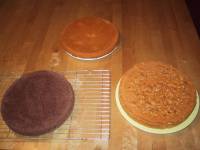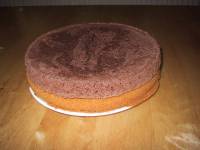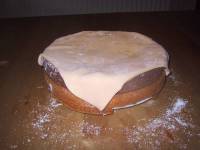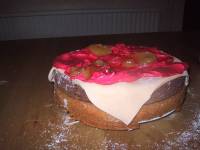February 07, 2006
Burger Cake
 The burger cake is one of the easiest novelty cakes to make, mainly because it requires the least artistic ability. Most of the impression of burger-ness is achieved through the choice of constituent cake. I first made this cake for one of my friends who had a summer job at McDonalds, but it's equally useful for a barbecue theme.
The burger cake is one of the easiest novelty cakes to make, mainly because it requires the least artistic ability. Most of the impression of burger-ness is achieved through the choice of constituent cake. I first made this cake for one of my friends who had a summer job at McDonalds, but it's equally useful for a barbecue theme.
Preparation
To make this cake you'll need:- 2x basic sponge recipe sandwich cakes (or 1 basic sponge cake baked in a normal tin and cut in half). Sprinkle chopped nuts over the top of one of the cakes before baking it to provide the sesame seeds on the top bun.
- 1x choclate whisked/fat-less sponge cake, the same diameter as the basic sponge cakes
- Roll-out icing coloured yellow
- Red butter-icing
- (optional apricot jam to hold everything together)
Assembly
 The initial cakes. Clockwise from top - the base bun of the burger; the top bun (complete with chopped nut topping); the burger itself. The burger is made from a whisked sponge rather than the basic sponge recipe because that will rise less than the sponge cakes used for the bun, and so provide a better thickness for the burger.
The initial cakes. Clockwise from top - the base bun of the burger; the top bun (complete with chopped nut topping); the burger itself. The burger is made from a whisked sponge rather than the basic sponge recipe because that will rise less than the sponge cakes used for the bun, and so provide a better thickness for the burger.
 The first step is to put the burger onto the bottom half of the bun. If you like, you can use some apricot jam to make sure that the burger doesn't move.
The first step is to put the burger onto the bottom half of the bun. If you like, you can use some apricot jam to make sure that the burger doesn't move.
 Now roll out a square of the roll-out icing. The side of the square should be roughly the same size as the diameter of the cake, so that when laid onto the burger the corners droop over the sides of the cake as shown.
Now roll out a square of the roll-out icing. The side of the square should be roughly the same size as the diameter of the cake, so that when laid onto the burger the corners droop over the sides of the cake as shown.
 Then you need to add the relish. For this I used red coloured butter-icing as ketchup, and because I had apricot jam to hand, I added some of that as onion relish. All that remains is to add the last cake as the top bun to finish the cake.
Then you need to add the relish. For this I used red coloured butter-icing as ketchup, and because I had apricot jam to hand, I added some of that as onion relish. All that remains is to add the last cake as the top bun to finish the cake.May 01, 2005
Basic Sponge Recipe
Ingredients
For each pint of liquid that the cake tin will contain, include:
- 2oz (50g) Soft margarine
- 2oz (50g) Caster sugar
- 2oz (50g) Self-raising flour, sieved. (Actually, I always use plain flour and add baking powder to make it into self-raising)
- 1 Egg
- A splash of milk
Or, for cake tins I've got:
| 2x 10" diameter, 1.25" deep round sandwich tins | 12oz mix (6 eggs) |
| 10"x10", 3" deep square tin | 14oz mix (7 eggs) |
In order to make a chocolate sponge cake (which, of course, is the best kind :) replace some of the flour with sieved cocoa powder - I usually use about an ounce (25g) of cocoa.
Method
- Grease and line the cake tin(s) with either greaseproof paper or baking parchment. Then grease the lining paper. I generally don't bother lining the sides of the tin these days - it's easy enough to run a knife round the sides after it's baked and it saves all the messing around lining the sides...
- Put the oven on to warm up whilst you're preparing the mixture. Gas mark 3 (170°C / 325°F).
- Cream the margarine and sugar together. This is easier if the margarine is at room temperature, rather than straight from the fridge.
- Gradually add the flour, cocoa and eggs, making sure that the ingredients are blended to a uniform consistency. Traditionally, this is the stage where you fold the flour and eggs into the mix, and are instructed to ensure you incorporate as much air as possible into the mixture. Although I do use what's largely a folding action, I still use the wooden spoon I used in the previous step (rather than a knife) and find that it's more important to ensure the ingredients are all mixed together well. If you sieve the flour into the mix from a reasonable height, I doubt you'll have any problems with not getting enough air into it.
- Add the splash of milk, and mix well. I'm not completely convinced that you need the milk - it may just be a superstition of mine, or merely my own personalization of the recipe - but I like a moist cake, and find that this helps. The amount I add depends on the consistency of the mixture at this point; sometimes it's as little as a teaspoon, and it's never more than a tablespoon or so. I suppose experience has taught me what sort of consistency I'm after, and so I can judge how much to add based on that, but I can't even begin to explain what that desired (by me, after all, your cakes will no doubt by subtly different) consistency is.
- Transfer the mixture to the cake tin(s) and put into the oven.
- Enjoy the remaining cake mixture from the bowl :-) (although you shouldn't if you're in one of the risk groups for eating raw egg! Shame.)
Baking times will vary, depending on how big the cake is. Do not open the oven in the first half hour of baking! An 8" cake will take around 45 minutes, and cakes made in my 10" square cake tin take about 1 hour 15 minutes. The cake is ready when a skewer slid into the centre of the cake comes out clean.
Once out of the oven, leave the cake in its tin for about five minutes to cool - during this time is will contract from the sides of the tin a little, making it easier to run a knife round the edges and remove from the tin onto a wire rack to cool properly.
April 29, 2005
Mmmmm.... cake....
I seem to be accumulating a backlog of "How to make" novelty cake postings, given that I've made four cakes in the past year and have yet to write any of them up. I'm hoping to at least start to clear the backlog in the next couple of days.
Before I do that though, it's high time I consolidated all of my cake-related web publishing onto one (i.e. this) site, rather than having some of the old stuff stashed away on my old homepage.
So just an advance warning for the impending cake flavour (sorry ;-) of this blog for a bit. I'm sure I'll be back to not posting anything soon...
April 07, 2004
Gruesome, But Great
I obviously need more time to work on my cakes so I can produce masterpieces like this dismembered body cake.
I particularly liked the idea of filling the cake with sauce which oozes out when the cake is cut, and the white chocolate ribs are inspired too.
October 31, 2003
Neil Asleep In A Chair
This cake is a prime example of the lateral thinking sometimes needed when deciding what to make for someone. My mate Neil is into mountain-biking, walking, dancing to Ricky Martin ;-) and has been quite the market-gardener this year, but none of that lent itself to expression in cake. Neil also has a talent for falling asleep at the end of parties, with his beer still in hand, yet never spills a drop - thankfully Lynne realised that this was a suitably cake-worthy subject, and so I could get on with the task of expressing the idea in sponge.
First off, you need to bake the cake. Had I been able to find my loaf-tin, I think it would've made a better basis for the chair, but I couldn't, and so settled on my 10" square cake tin. See here for the basic sponge recipe. Once baked you should have something similar to this.
Next you must cut the cake. There are four pieces to make up the chair: base, back, and two arms. In the picture, I haven't yet separated the arms, but they will come from the long thin piece. The larger of the other two pieces will form the back.
With the cake cut, it makes sense to do a dry-run assembly, to make sure it all fits together okay, while it's still easy enough to make adjustments.
Now you can mix a load of buttercream (I haven't got a recipe for that I'm afraid, I just throw butter, a little milk, and lots of icing sugar into a mixer until I get something of the right consistency. Usually I end up with far too much because I get the consistency wrong to begin with!) and use that to cement the pieces of cake together, and upholster the chair.
Finally, you need to create the marzipan "Neil" to sit on the chair. Break the marzipan into rough proportions ready for colouring: a small amount for the beer can, a bit more for his shoes, more again for his head and hands, and the remainder roughly into two halves, one for his legs and the other for his torso and arms. Once the marzipan is coloured, it's then a case of moulding it to the relevant shapes, and assembling into a person shape. Easier said than done, I know, maybe next time I make a figure I'll take pictures and describe it better. Fine details, like facial features, hair, lettering on the beer can, etc. are best applied in food colouring with a fine paintbrush.
All that remains is to present, and assist in the consumption of, the finished cake.
The Art Of Novelty Cakes
Anyone who has known me for any length of time will more than likely have sampled one of my cakes, and if they're lucky, they'll have been the recipient of one such confection. So, in the spirit of the great masters, and with a passing nod to londonmark, I present the Art of Novelty Cakes. Although this series will be a little less academic than Mark's, more vocational. My polytechnic to his "proper" university.
Cake is a wonderful medium in which to express oneself. It brings a whole new dimension of enjoyment to the consumer of the piece, for they literally get to do just that. In addition to the aesthetics of the cake, a good novelty cake will taste divine, and smell wonderful, and the true artist will bring this interplay of looks, tastes and textures together into the final work.
However, this brings us to the most important rule, and possibly the only immutable law in the art of novelty cakes: the cake must be eaten.
There will come a time when one recipient of a cake will proclaim "it is too nice to eat", and will want to keep it. For me, this happened with Julie's Pingu cake. It was kept in its box for the ten weeks of that summer term at university, untouched, and then transplanted, along with its marzipan penguins, to tin foil, so that she could return the cake box to me, and take the cake home. Maybe it still lies, mouldy, on a shelf at her parents'. Cake does not age well, like a fine wine, or a good Cohiba; any attempts to preserve it are destined to fail, and just deny the gustatory half of the experience.
The hardest part of any novelty cake project is the initial idea. This needs to be something which is relevant to the recipient of the finished cake, whilst also being achievable using the basic building blocks: cake, buttercream, and icing. For some cakes this will be obvious; the pool table for the avid player, the VW Golf GTI for the obsessed VW-fan (beware of combining roll-out icing with overly warm weather though...). Other cakes require more creative thinking; the bacon & egg buttie for the person who'll often rustle one up when you call round to see them, or the computer for the engagement of a work colleague. It helps if you have some knowledge of the interests and hobbies of the person for whom the cake is being made, but often restraint must be exercised, otherwise one could be tempted into designs which are too complicated or intricate to implement. Once the idea has been settled upon, then there is the minor task of bringing it into being.
There are four levels of competence on the path to the artist of novelty cakes.
- Assistant. Ideally for the first stage of the novelty cake craft, the student will train under the guidance of an accomplished master. Growing up, my sisters and I always had novelty cakes for our birthdays, and as I got older, I became well versed in the basics of the art by helping my Mum to prepare cakes for relatives' birthdays. Of course, initially, helping meant giving her more practice at applying chocolate buttons to the cake, by removing and eating those she'd already applied so she had to do it again, and licking the bowl (still one of the most important parts of any cake preparation). This progressed to more useful roles: applying the silver balls, then applying icing, and finally to helping design templates to aid cutting of the cake (during assembly, obviously no-one needs a template to tell them how to cut it when divvying up for eating :-)
- Imitation. The second stage marks the beginning of the student's branching out on their own. They make initial moves to see how their work may be received, either with simple forms imaginatively iced (such as my first solo piece, the alloy wheel) or copies of more elaborate items first prepared under the tutalege of the master (for example, the classic hedgehog).
- Realism. In this next stage, the artist's confidence is growing. Their ideas are becoming more ambitious but their quest for realism is often hampered by the limitations of sponge and icing.
- Acceptance. Finally, comes acceptance. Accepting of the materials available. Realisation that their role is not to recreate, but to capture the essence of the subject. To convey the impression of the subject. Realisation that in the best novelty cakes, the materials add to the piece, rather than getting in the way. The burger and the bacon & egg buttie are the best examples of this from the Adrian McEwen Portfolio.
What follows is not a foolproof method to recreate the cakes that I have made, merely some notes on how I made some cakes, at some point in time. To quote Nigel Slater in his excellent book "Appetite":
"I am convinced that a recipe should not be a set of rules to be followed to the letter for a mind-numbingly uniform result... Is that all there is to it? A recipe must work? Surely there is more to it than that[?]"